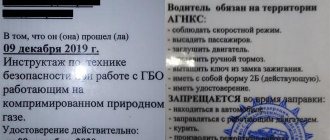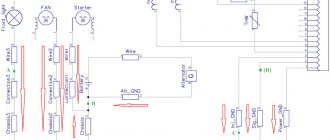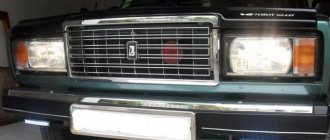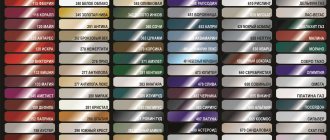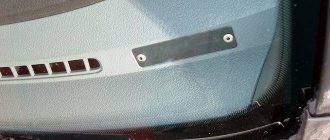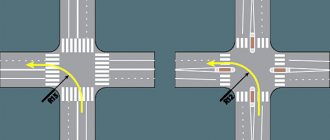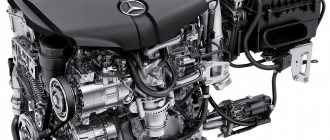Classes that indicate a car's environmental friendliness depend on what kind of exhaust gases are produced by the car's engine. You will learn what classes exist and their characteristics from the article.
Russia is a signatory to the Geneva Convention on Road Traffic, and therefore is subject to standards determining the composition of emissions. A number of regulatory documents have been adopted that establish the permissible amount of unsafe substances and vehicles that comply with these standards.
How many environmental classes do cars have?
- Consuming about 4 tons of oxygen per year (this is the average), the vehicle “releases” over a ton of carbon monoxide, hydrocarbons and nitrogen oxides into the atmosphere.
- It was the amount of harmful emissions (we are talking about nitrogen and carbon oxides and fine solids) in combination with the type of fuel used to operate the car that became decisive for the classification.
Ecology
- The assignment of an environmental class occurs during customs clearance, when a note about the appropriate class is placed in the vehicle’s technical passport.
- Today in Russia there are 5 classes of environmental safety of cars.
The impact of environmental class on the automotive market
The introduction of environmental standards has seriously affected the automotive market. The price of vehicles increases with each new class. All this is explained by the ever-increasing technology of cars. Each innovation forces manufacturers to come up with original engineering solutions that can reduce the amount of harmful emissions.
More technologically advanced cars, in addition to an increased price, receive a higher cost of scheduled maintenance. For example, replacing a catalytic converter, the main assistant in the fight against harmful emissions, costs on average 50-90 thousand rubles from an authorized dealer.
The power characteristics of modern engines are also seriously affected. They are strangled by various systems, their power is artificially reduced, and they are made less reliable. For example, dust from a catalyst can seriously damage the piston group of the engine: leaving scuff marks there, which will inevitably lead to a major overhaul.
Ecological class of Euro passenger cars in Russia
The standards provide for the following environmental classes for cars:
- Euro 1 - the introduction of standards began with it, moreover, for engines running on gasoline. The level of harmful exhaust components was monitored. This is a relatively low standard that the vast majority of cars can pass, but when it comes to air pollution, it is certainly not gentle.
- Euro 2 began to work in Russia in 2006 and already required a threefold reduction in harmful components in exhausts.
- Euro 3 no longer applies only to gasoline engines, but also to diesel engines. In addition, the permissible possible content of harmful substances in the exhaust has been significantly reduced - up to 40%.
- Euro 4 came to European countries in 2005, and to Russia another 5 years later, and again “demanded” a reduction in components hazardous to health and the environment in exhaust gases, by another 40%, when compared with Euro 3 .
- Euro 5 was introduced last, in 2015 (in Europe this standard began to work in 2009). In addition, class Euro 5 refers to mandatory conditions for the operation of machines with heavy lifting capacity sold in the European Union.
Euro 5
An exception
These standards do not apply to special equipment, the registration of which does not issue a PTS, PSM (passport for a self-propelled mechanism). A mandatory condition is the maximum possible speed on the highway is 40 km/h. Officials probably believe that diesel bulldozers and excavators will not harm the ecosystem when operating within, for example, a construction site. Well, a speed of 40 km/h makes the exhaust as clean as the morning breeze. This is for units whose diesel fuel consumption is 100 liters per hour of operation.
Ecological classes of trucks
- Freight vehicles must also have a note in their passport indicating which environmental vehicle class they comply with. As usual, trucks are assigned a second or third class. If the year of manufacture of the car is old (not “younger” than 2005), then the class usually corresponds to zero .
- By the way, increasing the environmental safety class is quite doable; for this it is necessary to re-equip the engine. This must, of course, be done not independently, but in specialized enterprises that issue a standard certificate stating that the re-equipment work has been carried out.
For freight
- You should contact the traffic police with this certificate and other documents for the car, where the class upgrade will be recorded, incl. and in the vehicle passport.
- But the latest generation of medium-tonnage MAZ, called the “Zubrenok”, has already reached Euro 5 standards in its development, although at the very beginning of the century it corresponded to the first class. This became possible thanks to the equipment with modern engines produced by the Yaroslavl plant, as well as the latest versions of German MAN.
Methods for determining EC
If a motorist is faced with the need to determine the EC, he should understand exactly how to find out the environmental class of his vehicle using a table, title or VIN code.
These three methods are the most effective and easiest to use.
We will analyze what exactly needs to be done and where to look separately for each method of checking the established environmental class of a car.
PTS
First, let's find out how you can determine the environmental class of your own car by simply opening the documents for the car. There is no need to go anywhere, call or write. Just look at the passport of your technical equipment or PTS.
Most drivers do not carry a passport with them in their car, and they do it absolutely correctly. That’s why it’s probably lying somewhere at home in a nightstand or closet. In fact, a title is only needed when buying and selling a car. Find the document.
If the car was registered relatively recently, then the environmental class mark should be located directly on line 13. It is written in words, and therefore there should not be any difficulties with decoding.
If you have had your PTS for more than 5 years, then a note about the eco-class may be present in the column where additional information is entered. But previously such marks were made very rarely. Therefore, only in exceptional cases will it be possible to find it.
When it was not possible to determine the environmental class using this method, move on to the next one.
Rosstandart
Rosstandart is a state organization that deals with vehicle certification issues. To make the life of drivers a little easier, special tables were invented and developed. It is from them that you can understand how to correctly find out the environmental class of your engine. Still, it is the engine that provokes the exhaust, not the body.
Based on the table, it is not difficult to obtain the necessary information. But at the same time, the motorist must know in advance about:
- the country and region where the car was produced;
- date of sale;
- manufacturing company.
Just keep in mind that this method of determination does not give a 100% accurate result, since the car could have been involved in serious accidents, after which major repairs were carried out. Engines are often changed, which is why the eco-class declared by the manufacturer does not correspond to the real values for a particular car.
Therefore, many agree that the best way to determine EC is to contact specialized companies. They provide services to determine environmental friendliness and have the appropriate certificates.
VIN code
If the previous two methods do not suit you for one reason or another, then you can use everything from Rosstandart, but add your VIN code to the search.
To do this, go to the official website of the department. There is a special column where the VIN is entered. Next, click on search and wait for a response to your request. When the system processes the data, you will receive a result containing the following information:
- your car type;
- make of the vehicle being checked;
- eco class approval number;
- date of signature of the class approval document;
- validity period of the document;
- specific environmental class.
In some cases, after entering the VIN code, the system does not produce anything. This is a common phenomenon, so there is no need to worry. The car was probably assigned an eco-class, it’s just that the VIN code is not in the department’s database.
Here we should take a different route. If necessary, contact the organization in person. If this is simple curiosity, then such events will be unnecessary. But when you plan to travel outside the Russian Federation, crossing state borders, be sure to find out the EC.
Do not forget that you will have to pay to obtain a certificate from Rosstandart. The current price for the service is 300 rubles.
Now you will know exactly how the environmental class of a car is determined and what it depends on. This is important information for some cases, without which you may simply not be allowed to leave the country.
On new cars there are practically no problems with the search. Just look at the PTS on line 13, where the environmental class of your car is indicated. But it also happens that it is not indicated in the vehicle passport. Here we should go in other ways.
What does zero environmental class of a car mean?
- If the car's passport indicates a zero environmental class of the car , this means that the car is quite old, produced even before the Russian Federation joined international norms and standards, i.e. until the beginning of this century. As a rule, the secondary market is filled with such vehicles.
Old car
- At the same time, a completely opposite situation cannot be ruled out - the car could be relatively new, released later than in 2005 (it was then that a mandatory class for Europe of at least Euro 4 was introduced). But if the environmental safety class is not specified in the documents at all, then when the car is registered, it is automatically assigned a zero environmental class in the vehicle passport.
- It should be noted that such cars, which have a zero class, have every chance of becoming the most expensive for their owners in terms of paying taxes. The more a car pollutes the environment (the lower its environmental class), the more tax the owner will have to pay - this is exactly the principle of the fiscal system that the country's legislators are increasingly discussing.
Ecology and transport tax
Taxation of transport is part of environmental legislation. The amount of mandatory payments is affected only by the engine power. It is worth noting that owners of cars powered by electricity are exempt from paying transport tax.
Subsequently, the main criterion determining the amount required to be paid will most likely be the environmental class of the vehicle. It is planned to introduce a fee of the same name. The higher the car’s safety index and the less its operation affects the environment, the better the savings.
This rule has long been relevant for most economically developed countries. Since the environmental situation remains difficult, the issue of protecting the atmosphere, flora and fauna occupies a leading position in the automotive market. It is important to remember this when planning to purchase an environmentally friendly car in the future abroad or in the Russian Federation.
What does environmental class 4 mean?
- Euro 4, or 4 environmental class of a car, is one of the types of environmental standards adopted in the European Union in 2005. In accordance with the norms of this standard, the maximum content in car emissions of carbon dioxide is set to 4, hydrocarbons - up to 0.55, carbon - up to 2 (all these quantities are measured in grams per kilometer).
- The standard lasted on Russian roads as a reference for three years. It was introduced in 2013, and starting in 2016 it was replaced by a new class, the fifth. It further reduced the permissible values for the amount of harmful impurities, but, of course, not all cars meet these more stringent standards for the environmental class of a car, primarily this applies to inexpensive cars on the market.
Fourth grade
Today, among the cars that comply with the Euro 4 class, we can name two Ladas - Grant and Kalina, a budget version of Nissan, and a Volkswagen Polo sedan.
- Buying an imported Euro 4 car today no longer makes sense , since it is impossible to obtain documents for it while going through customs. Accordingly, the car cannot be registered with the traffic police, and in this situation the age of the car, its mileage and carrying capacity do not matter.
- Therefore, only buying a domestically produced car can help out.
How did the development of environmental safety occur?
In Russia, the Euro 2 standard, which came into force in 2006, gained considerable popularity at one time. Compared to its predecessor, it has become 3 times stricter. It turned out that the demands of environmentalists did not stop there. It was replaced by Euro 3, which became even tougher by 40%. Its peculiarity was also that the requirements began to apply not only to gasoline, but also to diesel power units, including.
The Euro 4 criterion has moved even further in this regard, according to which vehicles again had to become 40% safer. It has been actively promoted around the world since 2005, but on the territory of the Russian Federation it was approved and began to be observed only 5 years later. At this time, the Euro-5 standard had already been prepared, but in our country it becomes mandatory only starting in 2015.
What does the fifth environmental class of a car mean?
- We have already examined the permissible standards of harmful substances contained in exhaust vapors for the Euro 4 . For comparison, it should be said that the environmental class of a Euro 5 car reduces the value of these indicators by more than half.
- But you shouldn’t think that these are some kind of strict restrictions, this is just a smooth transition to the next stage - Euro 6, which will be even more severe.
- In Europe, Euro 5 has been in force for 10 years, so it is mandatory for every car produced in 2009, starting in September. In Russia, these restrictions must comply with cars that were registered after 2015, when the country adopted the Euro 5 class.
- Compliance with it is determined not so much by the year in which the car was produced, but by technical parameters, including mileage, the absence or presence of special systems that reduce harmful emissions. It is also possible to retrofit the engine to suit your requirements.
About Euro 5
Differences between Euro 5 gasoline
EURO-5 fuel differs from its predecessors in its lower content of heavy metals and various impurities. In general, EURO 5 gasoline releases much less harmful substances when burned. This reduces exhaust toxicity. Now almost all gas stations that comply with the law sell Euro-5 fuel. By purchasing it, you can be sure of high quality fuel.
Cars of low environmental classes: list, names
- Today, the rules that impose restrictions on entry into a particular zone for cars with a low environmental safety class are becoming more and more strict. In particular, trucks whose class is less than Euro 3 are not allowed to enter the Third Transport Ring of Moscow, and entry to the Moscow Ring Road is allowed starting from the second class.
- At this time, cars with a low environmental class are considered to be those produced in European countries no later than 2004, in America - 2003, in Japan - 2010. Russian cars are classified as low environmentally friendly if they were produced no later than 2009 .
Since mid-2022, local authorities have received legislative rights to restrict the movement of cars that have high levels of harmful emissions.
- Starting from 2022, such bans will affect everyone whose engine has an environmental vehicle class from 0 to 2. Among them are all car models of the Zhiguli, Lada, Niva, and Samara brands produced before 2008.
- Ford Focus , which was produced in Vsevolozhsk until 2005, has a second toxicity class, like Kia Rio and Hyundai Accent , assembled in Taganrog.
Where to get information about your car
So, what practical benefit can a table that determines the environmental safety class bring us? Another question is where can one get this information?
It turns out that each car crossing our border is given the corresponding data in the vehicle passport (PTS) in section 13 or in “Additional notes”. That is, just look at the registration certificate to find out how safe your car is?
Absolutely true, and this is not the only option for defining environmental safety. There is also a Rosstandart database, although not everyone uses it yet. The so-called method is more popular in search queries: by VIN code, or in other words - by individual body or frame number. You can find it in different places of the body - this could be the engine compartment, door sills, dashboard and other areas, depending on the model.
This option is considered the most accurate and at the same time simpler in terms of implementation. There are special online services, which, however, are still connected to databases. We indicate the VIN number and receive reliable data, namely:
- vehicle brand;
- year of issue;
- category (class) of environmental safety, etc.
What does it mean that the car’s environmental class has not been established?
- As a rule, the environmental class of the car is indicated in the PTS. However, such a column appeared in this document only in 2006, when new technical regulations regarding emissions came into force.
- In this regard, it is generally accepted that the absence in the registration certificate of information about the assignment of an environmental class to the car’s engine means that this class is simply unspecified. And there are many such cars in Russia.
- In order to enter such data into the registration certificate, appropriate expertise is required. It is carried out at the NAMI testing center, which has the appropriate accreditation.
Cars without environmental class: list, names
- First of all, the list of cars without an environmental class includes cars that we call “retro”: this applies to both “Mustangs” and “Caddilacs”, as well as “Volgas” with “Pobedas” and “Zaporozhets”. produced before 2000 - from “kopek” to “seven”, “Lada” , produced before 2005 - all of them do not have an environmental safety class.
- This list also includes old European models Audi and Renault, Skoda and Volkswagen, as well as Opel and BMW.
- Like cars with a low environmental class, they will be subject to a ban introduced in 2021.
How to find out the eco-class of a car
The vehicle owner needs to determine the environmental class of the car to find out:
- what roads can he travel on?
- is there a need to re-equip to a higher standard;
- Is it possible to import the selected vehicle into the territory of the Russian Federation and clear it through customs?
Explore STS
One way to clarify this is to look at the front side of the STS, where the necessary information will be indicated in words in the corresponding line (see picture). However, such a column is only available in new STS.
If you have an old STS, it must be exchanged. Otherwise, from July 1, 2021, the car owner will be subject to signs 5.35, 5.36 and 8.25 (if the document is a new type, then the requirements of the signs are valid from July 1, 2018).
View in PTS
It’s easy to find out - just look in column 13 of the vehicle’s passport. In older PTS, the relevant information may be in a different place.
Find out from the Rosstandart table
Any car owner has the right to determine the environmental class according to the Rosstandart table:
Which environmental class of car is better?
- with a zero environmental safety class still travel freely today since citizens have quite a lot of vehicles that were produced in the last century and, accordingly, do not have any indication of this in the registration certificate.
- At the moment, the acceptable environmental safety class in the country is fourth - such cars have no restrictions on movement within the territory of the Russian Federation.
- Consequently, all lower classes can conditionally be called worse. And Euro 5, adopted in 2015, is, accordingly, the best, since it is more environmentally friendly. Officially, the requirements of safety standards are currently met by imported cars that came off the production line after 2014, and domestic cars produced no earlier than 2016.
The best so far is Euro 5
- In addition, a draft law is being developed according to which the amount of the transport fee will be considered an environmental tax and directly depend on the safety class. The tax will be high for owners of cars with a low class and will decrease with each higher class. So from this point of view, the dependence for the wallets of car enthusiasts is similar: the higher the class, the better.
- The highest class in the world today is Euro 6 , the standards of which do not yet work in the Russian Federation.
Descriptive characteristics of current classes
The first regulatory documents containing legal regulation of the permissible level of emissions of harmful and polluting elements appeared in 1992 - in connection with the increasingly deteriorating state of affairs in the world ecology.
This year is considered to be the beginning of the history of environmentally friendly car classes, which systematically began to be introduced in all developed countries.
Euro-1 is the very first class, introduced in the European Union in 1992 in order to classify vehicles equipped with gasoline internal combustion engines according to the level of their “harmfulness” to the environment.
This standard imposed minimum requirements for the level of emissions, so already in 1995 it was replaced by a more modern one. In the Russian Federation it was used until the fall of 2005.
Now there are practically no vehicles left in this category - they are either taken out of service or converted to an updated standard.
It began to be fully applied in Russia a year after its adoption - in 2006. The cessation of use as the main environmental class in the European Union occurred 7 years earlier than in the Russian Federation - in 1999.
This standard places more stringent requirements on the level of pollutants - in order for a car to be assigned it, the emission of harmful elements must be three times less than for the first standard.
Many domestic cars equipped with gasoline internal combustion engines and produced between 2006 and 2008 have this eco-class.
This standard is the first, which not only gasoline internal combustion engines, but also diesel ones must comply with. It acted as the main one in the countries of the European Union until 2005 - until the adoption of the more modern one - the 4th.
A key feature of the standard is that emission requirements are tightened by 40% compared to the previous one.
All vehicles that were produced on the territory of Russia or imported into it, starting from January 1, 2008, must have the 3rd Euro.
The presented environmental class was approved in our state as the main one only in 2010. The standard tightened the requirements for the emission of pollutants by 40% compared to the 3rd.
And from January 1, 2013, the import of vehicles from abroad and the production of vehicles in the Russian Federation with a class of less than fourth are prohibited.
Manufacturers producing machines in the EU must adhere to this standard:
- freight – since October 2008;
- passenger cars - since September 2009.
In the Russian Federation, the presented standard was adopted in 2015. The import of vehicles into our country with an environmental category below Euro 5 is prohibited starting from January 1, 2016.
Ecological class of the car for entry into Moscow
- The capital has taken seriously the task of improving the environmental situation. According to research, if you introduce restrictions on the passage of cars with a lot of dirt in the exhaust, the concentration of harmful impurities can be reduced by up to 30%.
- Therefore, since 2018, there have been amendments to the traffic rules that restrict cars with an environmental safety class lower than Euro 3 from entering certain zones of the city. And from the second half of 2022, a specific ban on driving under “environmental” signs will come into force if the environmental class of the car is low. The fine for such a violation is 500 rubles.
With what class is it possible?
- The rules already provide signs indicating such restrictions. At the same time, according to statistics, about a third of all cars in Russia have engines with an environmental rating even lower than Euro 2.
- Now another problem is being solved, related to the fact that data on the degree of environmental safety of the engine is present in documents issued after 2011. The absence of such a mark automatically makes the car subject to a ban, although in reality the engine may comply with the Euro 3 or even Euro 4 class.
Subtleties of increasing or decreasing the environmental class of a car
The operation of a car is never complete without replacing parts. Spare parts (namely catalysts) for cars of Euro-3, 4, 5 classes are not cheap, so car owners often refuse them. As a result of this restructuring, the car receives the first or second class of environmental friendliness. In our country there are no standards for regulating this kind of transformation.
If the environmental class of a machine is upgraded, re-equipment is carried out, after which a corresponding document is issued. If you have an old PTS and worn-out license plates, it is better to replace the entire set: new passports will already contain marks of an increased environmental class.
Ecological car class for entry into Europe
In Europe, there are widespread ecological zones that are restricted for cars with low-emission engines to enter. As a rule, heavy trucks and diesel-powered buses most often fall under such bans, but throughout the rest of the territory there are no additional requirements or bans.
- Without entering such an ecological zone, in European countries you can drive a car of any age, environmental friendliness index, or any type of fuel.
- Similar “clean” zones have long been defined in countries such as Austria, Belgium, Germany, Denmark, Spain and France. In the coming years, the Czech Republic will also join them.
- The Germans have determined the permissible entry into the ecological zone for cars, starting with the Euro 4 . Euro 1 are limited almost everywhere , and less often – Euro 3 . The Belgians are more loyal and if the car has a gasoline engine of a class lower than Euro 1 and a diesel engine lower than Euro 3, they can allow the car into the “clean” zone subject to additional payment.
- In Austria, Denmark and Spain, there are several options for environmental zones within the country, which have their own restrictions - in some places all cars are allowed, and entry is denied to trucks with an environmental vehicle class below Euro 4 .
Norms, requirements and restrictions on the environmental safety class of a car according to the law
- Today in the Russian Federation the current environmental standard meets the requirements of Euro 4 , which was adopted on the territory of the Russian Federation in 2010. It applies to both cars and trucks, and special equipment. At the same time, the accepted standard in Europe today is the sixth Euro class.
- To navigate the requirements for the environmental class of a car , below are data from European standards established for each of the standards regarding passenger cars.
- For greater convenience, we will consider diesel engines and gasoline engines separately. Let us remind you that values are measured in grams per kilometer.
For diesels:
- Carbon dioxide - from 2.72 in the Euro 1 class to 0.5 in the Euro 6 class. Accordingly, the content of unaccounted nitrogen oxides is initially limited to 0.08 in the Euro 6 standard.
- In addition, the permissible amount of volatile organic substances and suspended particles has been significantly reduced: from 0.97 to 0.170 and from 0.14 to 0.005, respectively.
Requirements
For gasoline engines:
- Carbon dioxide - from 2.72 in the Euro 1 class to 1.0 in the Euro 6 class . The content of nitrogen oxides in Euro 1 was not taken into account at all; in the Euro 6 standard it was 0.060.
- Hydrocarbons are also “regulated” by the 0.1 barrier in the Euro 6 standard, while initially its content was not taken into account at all. Volatile organic compounds are 0.068, suspended solids content is 0.005.
Let us recall that today's standard in Russia is Euro 4. Its limit values are: CO - 0.5 and NO - 0.25 - for diesel engines and, respectively, 1.0 and 0.08 - for gasoline engines (hydrocarbon content indicator - 0.1 ). Cars of a lower class can be imported into the Russian Federation, but their new owners are unlikely to be able to register them.
- Domestic machine builders at AvtoVAZ reformatted Lada production to the fourth standard in 2011, and for the export version they did this another 6 years earlier.
Where it all started
Since the environmental situation was terrible at the end of the 20th century, in 1992 the European Union countries adopted a list of regulations that regulated the concentration of toxic substances in automobile exhausts.
The first standard was called Euro 1. A few years later, a new declaration (Euro 2) was approved, which included stricter rules. Subsequently, thanks to the activities of environmental organizations, other European standards were adopted under numbers 3, 4 and 5.
In the Russian Federation, the Euro 2 eco-standard was first introduced in 2006. 2 years later, Euro 3 appeared, and in 2010, Euro 4. Currently, all cars imported into the Russian Federation must meet the highest Euro 5 standard.
It would seem that these documents were adopted at the level of the participating countries, and therefore do not concern ordinary citizens. Actually this is not true.
Note! No individual or legal entity can import a foreign car into Russia that does not comply with generally accepted standards.
Let's say a Russian bought a 2004 Opel in Italy and wants to transport it to his homeland. It will not be possible to issue a technical passport and register a vehicle in Russia, because in that year the Euro 3 standard existed on European territory, and in the Russian Federation at that time a higher one is used. Thus, you should pay attention to newer vehicles, on the release date of which the last class was introduced.
How to find out the environmental class of an engine by car make: list
There are ways to determine which environmental class a car belongs to:
- According to a certificate confirming the registration of the car. In those documents that have been issued in recent years, there is a special column indicating whether the vehicle belongs to a particular environmental class.
- This information may also be indicated in the vehicle registration certificate. True, without being included in the certificate, the actual environmental index of the car will still not be valid.
- To rectify the situation, it is necessary to make an appropriate appeal to the state traffic inspectorate and issue a new certificate, where all the necessary data will be entered.
- According to the car's passport. Again, in new passports there is a special column for this; in older ones, it is possible (but not necessarily) that data on the vehicle’s belonging to a certain environmental class may be in the line where additional information is indicated.
- Use the special table offered by Rosstandart. It presents two main indicators: the year of manufacture of the car and the country of origin.
- There are no Russian cars in it, because due to the difference in the time of introduction of engine environmental standards, the production time of foreign cars and domestic cars is incomparable.
- Following the data in the table, we can determine that American cars produced before 1996 have a class no more than Euro 1 , and therefore do not fall under the standard, newer cars, up to 2001 inclusive, correspond to the Euro 2 , until 2003. – Euro 3 , and since 2004 – Euro 4 , operating in the Russian Federation.
- Japanese cars do not meet the standard if their year of manufacture is earlier than 1997 (Euro 1), and then gradually: Euro 2 - up to and including 2004, Euro 3 - up to 2010 and Euro 4 - starting from 2011 .
- Korean transport has a low environmental class if it was produced no later than 2000, Euro 2 - before 2002, Euro 3 - before 2005, and after 2006 - Euro 4.
- The table also shows early car models from Canada, India, Malaysia, and Ukraine.
Table
What is ecoclass
Due to possible restrictions on the environmental class, the motorist is advised to find out which category his car belongs to. This will allow you to freely pass through customs checkpoints when crossing state borders, or you will immediately understand that there is nothing to do abroad with a car with an assigned EC.
First, you need to understand what the environmental class of your car means and what information a mark like Euro 4 provides.
Specialists deal with issues of environmental friendliness of vehicles. Environmentalists collect information and statistics that clearly demonstrate the level of danger and harm from automobile exhaust gases. According to experts, one car emits 4 kilograms of exhaust per year.
European countries, or rather their leadership, did not ignore this problem, and therefore developed the concept or definition of an environmental class for a vehicle. That is, each vehicle has its own safety class determined depending on how much it pollutes the environment. In this case, there is a ban and certain restrictions on the current environmental class if the car no longer meets the updated established current standards.
Within the framework of the adopted Geneva Convention, special environmental regulations were developed. And similar norms have been implemented in almost all countries of the world. To obtain permission to import cars, the vehicle must meet a certain environmental class. This is already determined by each country individually.
New standards were established in 2022 and are currently in effect. They provide:
- no more than 0.05 g/km CH;
- up to 0.8 g/km CO;
- no more than 0.06 g/km NOy.
All this complies with standards designated as Euro 5. At the same time, automobile companies continue to produce models whose eco-class complies with the requirements of Euro 4 and Euro 3. Anything below this value has been discontinued.
The task of the EC is to tighten current requirements for the level of environmental safety of operating vehicles. Such measures are aimed at preserving the environment. After all, exhaust is one of the most dangerous and harmful pollutants in the world. To combat this problem, environmental standards were developed, divided into classes.
Rosstandart: how to find out the environmental class of a car and truck by VIN online?
- The VIN code is usually indicated on one of the parts of the car: either on the engine, or on the body pillar, and maybe on the lower part trim, or on the door sill. In any case, this information is indicated in the PTS.
- To find out which environmental safety class your car belongs to, you should use the information provided on the official website of Rosstandart, in the relevant requests section.
- You will need to enter the numbers of your VIN code, and you will be able to find out not only what environmental class the car belongs to, but also many other data, for example, what type of car is yours, its make, when the document was issued and how long it is valid.
- If this method does not help you, there is only one way out - contact the traffic police and conduct an examination.
Code
Results
One of the indicators that influences the applicable transport tax rate may be the environmental class to which a particular vehicle belongs. Whether to use it depends on the decision made when setting rates in the region.
The class number is indicated in the PTS of a modern vehicle in a specially designated line. If the PTS is issued on an old form, then information about the environmental class number may be reflected in the “Special notes” column.
Sources:
- Tax Code of the Russian Federation
- By decision of the Customs Union Commission dated 09.12.2011 No. 877
You can find more complete information on the topic in ConsultantPlus. Free trial access to the system for 2 days.
How to change the environmental class of a car in the PTS?
- If you do not know the environmental class of the car, you should contact an authorized dealer and find out this question. If the class meets the requirements, you will receive a document in the form of a certificate confirming the approval of this type of car. And then you go to the traffic police and put the appropriate mark in the PTS.
- If the environmental safety class does not meet the standard, then it is possible to re-equip the machine so that the concentration of prohibited substances is reduced. This can be done in certified companies, since you will need to provide the issued document on conversion to the traffic police.
- The environmental class could be lowered as a result of the fact that during operation certain engine parts could be worn out or replaced. In this case, you need to bring all components and parts into compliance.
- And finally, you can refer to the fact that the legislation does not currently require a mark in the vehicle title indicating that the car belongs to a certain environmental class. True, very soon this option will become problematic.
Change class
What to do and where to go?
So, you opened the PTS and did not find column 13 and no special marks or saw that “the environmental class has not been established.” In this case, it is necessary to enter information about the environmental class in the “Special Notes” in the PTS. Only registration departments of the State Traffic Safety Inspectorate have this right, but to do this you must provide a document confirming that your car actually complies with this environmental class. And here the burden of proof falls entirely on the owner. How to prove it? It is immediately worth noting that today not a single regulatory document gives a clear (read, any) answer to this question. Thus, the currently valid Technical Regulation of the Customs Union TR CU 018-2011 “On the safety of wheeled vehicles”, which defines the technical requirements for automotive vehicles and the procedures for confirming compliance with these requirements, in no way regulates the methods of confirming environmental safety for cars that already issued for circulation on the territory of the countries of the Eurasian Union (including Russia), with the exception of the technical inspection procedure. And since the car has a PTS, it means that it has already been released into circulation, since the date of release of the vehicle into circulation is the date of the initial issue of the Russian PTS.
But a technical inspection does not help here either, because according to Appendix No. 8 (clauses 9.1, 9.2) to TR CU 018-2011, in order to assess the performance of the engine and its exhaust systems in terms of emission standards, it is necessary to indicate the environmental class of the vehicle being tested in order compare actual emissions with acceptable values. That is, it is impossible to establish during the technical inspection what you should know in advance. The curious thing about this situation is that all cars whose environmental class is not indicated in the documents undergo technical inspection in violation of the requirements of TR CU 018-2011, i.e. illegally. And since such cars are a dime a dozen in our country, it is obvious that at least once almost every maintenance operator has issued a diagnostic card for such a car. However, everyone turns a blind eye to this...
But let's return to the proof process. Obviously, the absence of clear requirements for establishing an environmental class thereby creates an incredible corruption component, including a free hand for the traffic police, who begin to demand various types of evidentiary materials from owners. It is interesting that there is a list of documents that can be accepted for consideration for entering information about a vehicle; it is present in paragraph 39 of the “Regulations on vehicle passports”. It says that this information is filled out “... on the basis of OTTS, SBCTS, and in their absence ... on the basis of officially published technical specifications, reference books, tables and other documents.” Let's figure it out in order. So, where can a simple car owner get OTTS ? The original of this document is kept either by the manufacturer (for Russian-made vehicles) or by its official Russian representative office (for vehicles manufactured outside the Russian Federation). The only problem is that manufacturers and their representatives rarely issue certified copies of their approvals to car owners. This is understandable: in their opinion, OTTS is an internal document, and its content is a commercial secret, and therefore it can only be officially requested at the request of supervisory authorities. Unfortunately, the traffic police are in no hurry to bother themselves with these requests, and interested vehicle owners are practically deprived of such an opportunity.
Meanwhile, there is one problem that emerges after you have managed (if you have managed!) to get a copy of the OTTS that applies to your car. If you, for example, have a 15–20-year-old “European”, then in his approval issued by the State Standard of Russia in the same years, information about the environmental class will be indicated indirectly - in the table of Appendix No. 1 (Summary sheet) in the form of “ecological » UNECE Rules with one or another amendment, confirmation of compliance with the requirements of which will denote the corresponding “Euro”. But this identification can only be carried out by a certification specialist. The “traffic cop”, having not found the column “Environmentally class” on the title page of the OTTS (let me remind you, it appeared only in OTTS issued since April 21, 2006), in 99% of cases he will say that such type approval is not suitable. This means that you will have to apply for an examination that will confirm the availability of information about a specific environmental class in a specific OTTS (more on this later).
The second document is SBCTS (vehicle safety design certificate). This is a relatively recent certification document that appeared in connection with the entry into force in September 2010 of the first (still Russian) technical regulation on the safety of wheeled vehicles (approved by Decree of the Government of the Russian Federation No. 720 of September 10, 2009). SBKT is issued for single vehicles, including used ones, which are imported from abroad. For our topic, this document is of little relevance due to the youth of this procedure and due to the fact that if an SBCTS was issued for a car, it means that a PTS was also issued on the basis of this certificate. And if so, then the environmental class must be specified in the passport. Sometimes the demands from individual traffic police officers to confirm the environmental class to provide an SBCTS for a car, say, 1998, for which the Russian title was issued, for example, in 2003 (i.e., a used foreign car was imported) sometimes seem completely stupid, since a certificate is issued for a car to obtain permission to put it into circulation, and the release into circulation is the issuance of a PTS. Consequently, permission to release into circulation cannot be obtained after the release has already been officially made.
Now let's turn to the official reference books, characteristics and tables. This very vague definition is generally understood by all industry specialists. To put it into simple language, the vehicle owner can make an official request to the manufacturer and his representative, who will respond in writing that such and such a specific car with such and such a VIN code, according to the manufacturer, has such and such an environmental class . Such official letters are written in batches, and most often manufacturers/representative offices do not take any money for this (though not all of them - some still try to speculate on this and have approved price lists for such a service). In fact, this is the easiest way for the owner, if not for one “but”. When the first environmental restrictions first appeared in Moscow, many owners, in order to get around them, presented such certificates with a “slightly overestimated” environmental class to the traffic police. It is not clear how this happened: either the letterheads and seals were forged, or for an unofficial “reward” the manufacturers acquiesced and attributed extra money. But such facts were revealed, and, as they say, in considerable quantities. Since then, employees in uniform have had nothing to do with these certificates and send the owners for OTTS or for examination.
An expert opinion is the very option that is hidden behind “other documents” . Now the Internet is replete with similar offers. Most often, small commercial offices offer to “install” the required environmental class for money (currently the maximum required is “third”, but for some people “second” is enough), issuing beautiful pieces of paper with loud names like “Ecological Certificate”, “Certificate of Environmental Safety” etc. - who knows what. The technical supervision of the traffic police also knows about this, so they usually send a similar conclusion to more or less reputable organizations, for example, NAMI. Such a conclusion can be very relevant if it is not possible to find the OTTS on your own or if the environmental class is not specified on the title of the OTTS.
The whole problem is that, unfortunately, the simultaneous presence of OTTS, an expert opinion and even a letter from the manufacturer does not at all guarantee that the traffic police will put an environmental class mark on your PTS.
There is talk behind the scenes that they are now simply afraid to do this, since there is an unspoken order from above to clear the market of old “rydvans”. Of course, this is, to put it mildly, not entirely legal. Therefore, if you are faced with a refusal from the traffic police in the presence of documents confirming the environmental class, then the only way to resolve the conflict is to go to court. The chances of success here are really high, because any refusal will have to be argued in the legal field, and the traffic cops, as a rule, have nothing to cover up here. UNECE rules regarding environmental safety of vehicles and their applicability
| UNECE Regulation No. | Vehicle category | engine's type | Object of rationing |
| 24 | M, N | Diesels | Visible pollutants (particulate matter, soot - PT) |
| 49 | M1, M2, N1 N2 (control weight over 2160 kg) and M3 N3 | Diesels and gas engines (LNG and CNG) | Gaseous pollutants (CO, CH, NO) |
| 83 | M1, M2, N1 N2 (control weight not more than 2160 kg) | Diesels, petrol and gas | Gaseous pollutants (CO, CH, NO) |
| 96 | Tractors and off-road mobile equipment | Diesels | Gaseous (CO, CH, NO) and visible (soot) pollutants |
Changing and increasing the environmental class of a car in the traffic police step by step
To make changes to the PTS relating to the environmental safety class, you must contact the State Traffic Safety Inspectorate, namely the MREO. This must be done if the car was manufactured earlier than 2008.
To change the data on the environmental class of a car, you need a certificate of conformity. It can be obtained by contacting an official dealer or by conducting an examination.
To change the environmental class of a car in the traffic police step by step:
- Step 1. To make changes to the PTS of a car purchased in the Russian Federation, you must contact the factory that produced it or the nearest representative office to obtain an approval number.
- Step 2. If you cannot obtain a document from the dealer, you should contact a certified company for an examination that will determine what class the car belongs to.
- Step 3. If environmental safety turns out to be low, you need to re-equip the car: adjust the fuel system, install filters, etc. After this, apply again for an expert opinion.
- Step 4. Taking with you your passport and all documents related to the car, an expert opinion or certificate of approval, submit all this to the MREO, where changes are made to the title.
- Step 5 . Pay 350 rubles in state duty.
Origins of alarmism
The initiators of the struggle for environmental safety were the Moscow authorities, who, trying to keep up with the times and catch up with advanced countries in this regard, were actively concerned with environmental problems.
One of the main factors that negatively affect the environment is emissions of harmful substances from motor vehicles (primarily exhaust gases and solid particles contained in them). In the capital region, the daily concentration of cars per 1000 residents is the densest in Russia. Moreover, we are talking not only about cars registered in Moscow (as of January 1, 2017, it took only third place after Samara and St. Petersburg - 307 units / 1000 people), but also about those with regional registration and transit transport .
Naturally, it was Moscow that became the pioneer in introducing restrictive measures for the entry of “unclean cars” into its territory. Today, these restrictions are as follows: in order for a car to be operated in the capital (within the Moscow Ring Road), a necessary condition is that it must comply with at least the third environmental class (Euro 3), and for operation on the Moscow Ring Road – the second (Euro 2).
And while all the transport workers whose logistics are tied to the Moscow region were cursing the capital’s bureaucrats for the draconian measures, a fresh decree of the Government of the Russian Federation No. 832 of July 12, 2022 arrived, which makes changes to the traffic rules.
In particular, this resolution provides for the introduction from July 1, 2022 of special road signs (5.35–5.38 and 8.25) limiting the movement of vehicles below a certain environmental class. This means that already in mid-2018, environmental restrictions may be introduced in many Russian cities, since local authorities are installing road signs. And they can install them at their own discretion. At the same time, the validity of the signs can extend not only to commercial vehicles (in other words, trucks and vans), but also to ordinary passenger cars for personal use.
